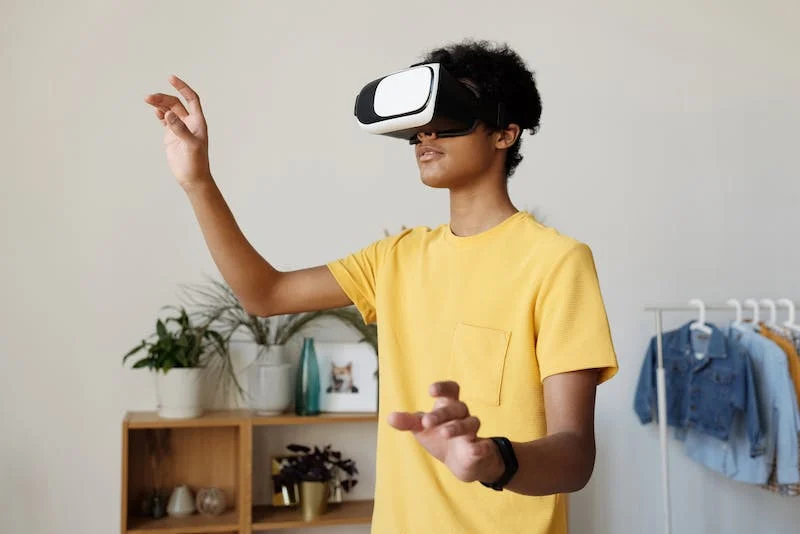Contents
What are Virtual Reality (VR) and Augmented Reality (AR) and the metaverse world ?
Virtual Reality (VR) and Augmented Reality (AR) are immersive technologies that alter our perception of the physical world by adding or substituting digital elements. While they share similarities in creating interactive and immersive experiences, they have distinct differences:
- Virtual Reality (VR):
- Definition: Virtual Reality is a technology that creates a completely immersive, computer-generated environment in which users can interact with a three-dimensional virtual world. It typically involves wearing a VR headset that covers the user’s field of vision and may include additional sensory feedback devices like motion controllers and haptic feedback.
- Immersive Experience: VR aims to transport users into a fully digital environment, isolating them from the physical world. This immersion can be so intense that users feel as if they are physically present in the virtual world.
- Applications: VR is used for a wide range of applications, including gaming, simulation training (e.g., flight simulators), architectural visualization, healthcare (e.g., pain management and exposure therapy), education, and entertainment.
- Augmented Reality (AR):
- Definition: Augmented Reality overlays digital information or objects onto the user’s view of the real world. AR is typically experienced through a device like a smartphone, AR glasses, or a heads-up display. It blends the physical and digital realms, enhancing the user’s perception of reality.
- Semi-Immersive: Unlike VR, AR does not immerse users in a completely digital environment. Instead, it adds digital elements to the existing physical world, allowing users to interact with both simultaneously.
- Applications: AR has diverse applications, including mobile gaming (e.g., Pokémon GO), navigation (e.g., AR directions overlaid on maps), industrial maintenance (e.g., providing repair instructions), healthcare (e.g., aiding in surgeries), and marketing (e.g., interactive advertisements).
In summary, VR creates a wholly digital environment where users are fully immersed, while AR enhances the real world with digital elements. Both technologies have unique use cases and are continually evolving, with applications extending into various industries, from entertainment and education to healthcare and enterprise solutions. Mixed Reality (MR) is another term often used to describe experiences that blend elements of both VR and AR, allowing for interaction with digital objects in the real world and vice versa.

How does Virtual Reality (VR) technology work in the metaverse?
Virtual Reality (VR) technology plays a crucial role in the development and functioning of the metaverse by providing immersive and interactive experiences within the digital environment.
- VR Hardware: Users access the metaverse by wearing VR headsets or goggles. These devices are equipped with high-resolution displays, motion sensors, and often incorporate audio systems. Some advanced VR systems also include hand controllers or gloves for more natural interaction.
- Creating a Virtual Environment: In the metaverse, VR technology relies on powerful computers or cloud-based servers to generate and render the virtual environment in real-time. This digital environment can be anything from realistic representations of physical spaces to entirely fictional or abstract worlds.
- Tracking and Movement: VR headsets track the user’s head movements and position in real-time using sensors like gyroscopes and accelerometers. This tracking allows users to look around, move, and navigate within the virtual space, creating a sense of presence.
- Interactivity: VR controllers or hand-tracking systems enable users to interact with the virtual environment. These input devices allow users to manipulate objects, perform actions, and engage with the metaverse’s content. For example, users can pick up virtual objects, draw in 3D space, or control avatars.
- Immersive Audio: VR systems often feature spatial audio technology, which simulates the direction and distance of sounds within the virtual environment. This enhances immersion by providing realistic audio cues that match the user’s perspective.
- Networking: To enable social interaction within the metaverse, VR systems rely on high-speed internet connections. Users can connect with others in the virtual space, communicate through voice or text chat, and participate in shared experiences, such as collaborative work or multiplayer games.
- Content Creation: Developers and creators use various tools, including 3D modeling software and game engines, to design and build the virtual worlds and assets within the metaverse. User-generated content is often encouraged, allowing individuals to contribute to the metaverse’s growth and diversity.
- Persistence: In the metaverse, the concept of persistence is crucial. This means that changes made to the virtual environment, objects, or user-created content should persist over time. It allows for ongoing development, social interaction, and economic activities within the metaverse.
- Security and Privacy: As users interact within the metaverse, security and privacy measures are essential to protect personal data, prevent unauthorized access, and ensure a safe online environment. This is particularly important in shared virtual spaces.
- Economy and Transactions: Some metaverse platforms incorporate virtual currencies, blockchain technology, and economic systems that enable users to buy, sell, or trade virtual assets and services. This creates a virtual economy within the digital space.
In summary, VR technology in the metaverse provides users with a highly immersive and interactive digital experience. It enables them to explore, socialize, collaborate, and engage with both the digital and physical worlds in ways that were previously only imaginable in science fiction. The goal is to create a dynamic and interconnected metaverse where users can interact with each other and digital content on a profound level.
How does Augmented Reality (AR) technology work in the metaverse?
Augmented Reality (AR) technology plays a significant role in the metaverse by enhancing users’ perception of the physical world with digital elements and information.
- AR Hardware: Users access the metaverse through AR devices, which can include AR glasses, smartphones, tablets, or heads-up displays (HUDs). These devices are equipped with cameras, sensors, and displays to capture the real-world environment and overlay digital content onto it.
- Real-World Environment: AR technology relies on the user’s physical surroundings as a base. It uses the device’s camera and sensors to continuously scan and understand the real-world environment, including objects, surfaces, and their positions.
- Digital Overlays: In the metaverse, AR technology superimposes digital content onto the user’s view of the physical world. This content can take various forms, such as 3D objects, information, graphics, animations, and text. It appears as if it exists within the user’s real-world environment.
- Positional and Spatial Tracking: AR devices use positional tracking technologies like SLAM (Simultaneous Localization and Mapping) to understand the user’s location and orientation in the physical space. This tracking is essential to ensure that digital content aligns correctly with the real world as the user moves.
- Interaction and Input: Users interact with the augmented content using gestures, touchscreens, voice commands, or physical controllers. These interactions can range from tapping on virtual buttons to manipulating and moving digital objects within the user’s field of view.
- Networking and Social Interaction: AR devices are connected to the internet, allowing users to engage in social interactions within the metaverse. Users can communicate with others, share information, and participate in collaborative experiences or multiplayer games.
- Content Creation and Integration: Developers and creators use AR development platforms and tools to design and integrate digital assets and experiences into the metaverse. This includes creating 3D models, animations, and interactive applications that can be overlaid onto the real world.
- Persistence: Like VR, persistence is crucial in the AR metaverse. Digital overlays and user-generated content should be able to persist over time, enabling users to leave their mark on the shared augmented reality environment.
- Security and Privacy: As with any online environment, security and privacy measures are important in the AR metaverse to protect user data and ensure a safe and trustworthy experience.
- Economy and Transactions: Some AR metaverse platforms incorporate virtual currencies, allowing users to engage in economic activities such as buying and selling virtual assets or services. These transactions may use blockchain technology to ensure transparency and security.
In summary, AR technology in the metaverse enhances the user’s perception of the physical world by overlaying digital elements, information, and experiences. It enables users to interact with both the real and digital realms simultaneously, making the metaverse a dynamic and engaging space where users can explore, socialize, work, and play in new and exciting ways.




